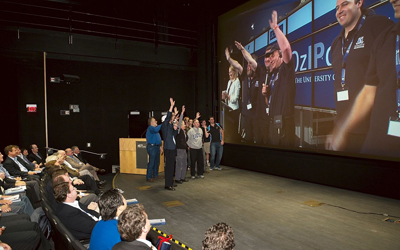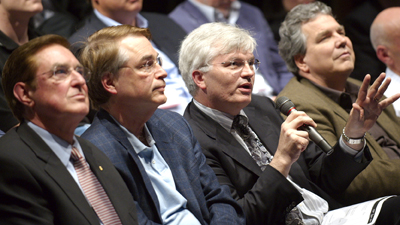Calit2 and University of Melbourne Initiate Australia's Ultra-Resolution Global Collaboration Laboratory
San Diego, CA, and Melbourne, Australia, January 16, 2008 -- Members of the Australian American Leadership Dialogue (AALD) meeting at Calit2 in San Diego were linked over a super-broadband network to the University of Melbourne's new OptIPortal tiled wall display (based on technology first developed by the Calit2-led OptIPuter project).
|
In an Australian first, this next-generation platform – set to revolutionize the way Australia interacts with the rest of the world – allows real-time, interactive collaboration across the globe, combining high-definition video and audio with the sharing of ultra-resolution visualizations from a broad range of disciplines. Today’s demonstration was an initiative of the Australian American Leadership Dialogue (AALD). The organization held its West Coast Leadership Dialogue at UC San Diego's Graduate School for International Relations and Pacific Studies (IR/PS), and the meeting was hosted by IR/PS Dean Peter Cowhey, a long-time academic participant in the UCSD division of Calit2.
|
Funding for the OptIPortal has been provided by the Victorian Government ($120,000) and the University of Melbourne ($500,000).
This ultra-resolution OptIPortal visualization wall – the largest in Australia – enabled scientists, industry leaders and politicians in Melbourne to demonstrate cutting-edge medical and environmental research to participants in the AALD’s meeting at UC San Diego using a novel interactive high-definition television stream over a 1000 megabit/sec (“gigabit/s”) super-broadband optical fiber connection.
|
The link-up was made possible by use of the high-capacity backbone of AARNet, Australia’s academic and research network, with a connection to the U.S. West Coast using SXTransPORT on the Southern Cross Cable Network to the Calit2 network in San Diego via Pacific Wave and CENIC.
In Melbourne, Deputy Prime Minister Gillard and Premier Brumby joined Victorian Opposition Leader Ted Baillieu, Federal Minister for Innovation, Industry, Science and Research Senator Kim Carr, Federal Opposition Education spokesman Tony Smith and Qantas Chairman, Leigh Clifford.
|
Amanda Johnston, an Executive Director at BigPond, co-moderated the discussion in Melbourne with Phil Scanlan, founder of the Australian American Leadership Dialogue, in San Diego.
Unique in Australia, the OptIPortal facility brings together two individual concepts: ultra-resolution visualization walls and high-definition video collaboration technologies, creating a powerful new tool enabling collaborative research across great distances in real time with participants visually exploring massive data sets.
|
Dean of Engineering at Melbourne, Professor Iven Mareels, says, “The ‘real-time’ nature of the technology means people on opposite sides of the world can work together on projects in real time. For instance, a surgeon in Australia could direct an emergency surgical intervention by operating a robot in Antarctica; scientists in Australia and Japan could share research tools such as the Synchrotron, or operate an underwater robot exploring the Great Barrier Reef – all from the comfort of an OptIPortal room.”
|
“This is a landmark event for Australia-U.S. research communities and represents a quantum leap in broadband communications for Australia,” says Chris Hancock, CEO of AARNet. “It means research teams in areas such as medicine, astronomy, science and technology can now visualize larger, more detailed, higher resolution images than ever before. This technology opens up a world of opportunities for collaboration across the Pacific and helps to ensure Australia’s place at the forefront of global collaborative research.”
|
The University of Melbourne demonstration marks a major milestone in Australia’s triumph over the ‘tyranny of distance’ – from its first overseas telecommunications link in 1872, first overseas airmail in 1935 and passenger flight, 1935, to its first overseas Internet connection at the University of Melbourne in 1989.
About the OptIPortal
With nearly 100 million pixels in view, compared to one or two million pixels for a typical PC screen, the Melbourne OzIPortal’s HIPerSpace tiled display provides amazing ultra-resolution visualisation.
It was built in collaboration with the OptIPortal team, including experts at the UCSD and UCI campuses of Calit2, at the San Diego Supercomputer Center, and at the Electronic Visualisation Laboratory at the University of Illinois at Chicago.
This technology opens exciting news ways of performing research. Researchers across the globe will be able to share unique instruments – MRIs, synchrotrons, supercomputers, square km radio telescope arrays – and collaborate to interpret, on the spot, complex data which could range in origin from the artistic world, gaming and cinematography to leading-edge advances in the characterization of brain function and the human genome.
The current facility will be expanded in a straightforward and modular way to include other collaborators at different sites in Victoria and in other parts of Australia.
With the OptIPortal, scholars in different locations can appreciate the fine details of a work of art, medical scientists can explore a range of images of the brain from different scanning sources all at one time, researchers can explore new materials constructed by computer.
In a city such as Melbourne, planners can explore, all at once, population density, ethnicity, crime patterns, water consumption, socio-economic factors, and so on. Students in schools and universities can ‘go on exchange’ with overseas institutions without leaving their classroom. In medicine, it holds the promise of providing access to high-quality, specialized expertise for health professionals in regional Australia or even Antarctica.
The OptIPortal is connected over AARNet’s trans-Pacific fiber optic network and uses high-definition video. AARNet has pioneered the global use of high-definition television streams since 2004 and now adds in the capability of ultra-resolution visualization.
The resulting OptIPlanet Collaboratory means we can interact with a remote location just as if it was ‘right here’.
Some Statistics
OptIPortal definition: Combination of a high-definition wall (comprised of 24x30 inch ultra HD monitors) powered by 13 Quadcore PCs (which are equivalent to 52 standard desktop PCs)
The OptIPortal has 100 times more memory than the average desktop PC (104 Gigabytes)
The OptIPortal is nearly 50 times higher resolution than the highest-resolution HD TV commercially available.
The Internet connection (1 Gigabit per second) is about 250 times faster than the standard broadband connection offered in metropolitan Melbourne (4mbps)
The software that powers the OptIPortal is capable of magnifying images to a large size and still keep full clarity, for instance, a scan of the brain can be shown at to the cellular level and maintain full clarity.
The 'secret sauce' that allows Melbourne's OziPortal to be able to show the stunning images shown today is the Cluster-GL for Heterogeneous Systems (CGLX) framework for freely scalable multi-tile visualisation and synchronization.
Melbourne’s OzIPortal utilizes Calit2’s HIPerSpace technology for freely scalable multi-tile
visualisation.
About the University of Melbourne
The University of Melbourne is Australia’s leading research university, based on a number of indicators. The Times Higher Education Supplement recognized Melbourne as Australia’s leading university in technology teaching and research. The University - the gateway for Australia’s first overseas internet connection in 1989 – is at the forefront of ICT research in Australia through key research centres, CUBIN (Centre for Ultra Broadband Information Networks) and NICTA (National ICT Australia).
About AARNet
AARNet Pty Ltd (APL) is the company that operates Australia's Academic and Research Network (AARNet). It is a not-for-profit company limited by shares. The shareholders are 38 Australian universities and the CSIRO. AARNet provides high-capacity leading edge Internet services for the tertiary education and research sector communities and their research partners. AARNet serves more than one million end users who access the network through local area networks at member institutions. For further information, please visit: www.aarnet.edu.au.
About AALD
Founded in 1992, the annual bipartisan Australian American Leadership Dialogue alternates between Washington DC and a major Australian capital city. In recent years, the Leadership Dialogue has also accessed the best institutional infrastructure on the west coast of the USA, in order to engage some of their best and brightest about the next phase of nation building in both countries.
About Calit2
The California Institute for Telecommunications and Information Technology (www.calit2.net), a partnership between UC San Diego and UC Irvine, houses over 1,000 researchers organized around more than 50 projects on the future of telecommunications and information technology and how these technologies will transform a range of applications important to the economy and citizens' quality of life. www.calit2.net
About the OptIPlanet Collaboratory
Based on the “OptIPuter” research project (www.optiputer.net) funded by the U.S. National Science Foundation for six years, 2008 will see the establishment of a persistent global collaboration laboratory combining high definition and digital cinema video streams with ultra-resolution visualisation facilities, termed the OptIPlanet Collaboratory, connecting many centres for innovation around the world.
Related Links
OptIPuter
AARNet
University of Melbourne
Media Contacts
Media Contacts: Doug Ramsey, 858-822-5825, dramsey@ucsd.edu or Christina Buckridge, University of Melbourne, 0412-101-316, c.buckridge@unimelb.edu.au







